The best Canon telephoto lenses in 2022: for your DSLR or EOS R series camera
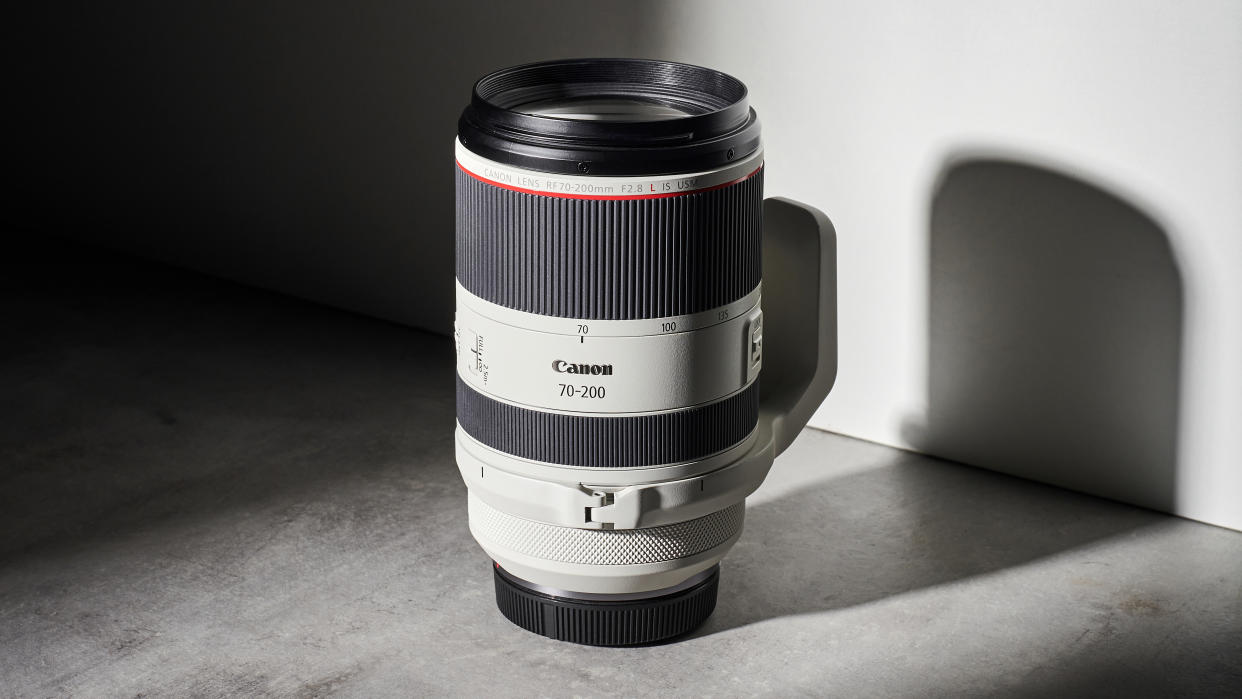
The best Canon telephoto lenses make it easier to fill the frame with subjects and get closer to the action to ensure you capture stunning photos. You can use these zoom lenses to shoot sports, wildlife, portraits and even landscapes, so they're essential companions to your Canon camera.
There are several types of Canon camera and each has a different lens mount; the best RF lenses pair with Canon's mirrorless range, EF lenses are for Canon DSLRs, while EF-M lenses pair perfectly with Canon's EOS M cameras. In this guide, we've focused on RF and EF lenses, with one great EF-M lens at the bottom. You'll find out the mount type by looking at the mount in the specifications.
Why buy the best Canon telephoto lens?
If you're a serious wildlife or sports photographer then owning a telephoto lens is a must. Telephotos cover a range of common focal lengths, including 70-200mm lenses and 150-600mm lenses, but they all enable you to pick out finer details in the distance and still produce a sharp, clear image. Using a zoom lens also means you don't have to be too close to your subject which is perfect when you're shooting wildlife and you don't want to scare animals away.
Likewise, if you're a sports photographer you'll often be in a defined area so you'll want to make sure you can still capture some great pictures, even if you're on the far side of the track, pitch, or court.
Telephoto lenses have many uses and are great for producing different perspectives to wider options. They have a lot less distortion which makes them great for picking out details in a landscape and the longer focal lengths enable you to achieve greater separation between your subject and background. For this reason, portrait photographers will shoot with a telephoto lens so that they have a beautifully blurred background in their image.
So how do you choose the best camera lenses for you? While there are some incredible Canon lenses, lots of third-party brands such as Tamron or Sigma make equally good lenses that are more affordable. Take the Canon EF 70-200 f/2.8L IS III, for example, it's a professional lens for DSLR photographers but costs $2699/£2000, whereas the equivalent Tamron SP 70-200mm f/2.8 Di VC USD G2 weighs less and is half the price.
In this guide we've compiled the best Canon telephoto lenses, taking price and performance into consideration. Catering to a range of requirements and budgets, it includes relatively small, compact zoom right up to powerful super-telephoto lenses.
Best Canon telephoto in 2022
Best Canon telephoto lenses for RF mount
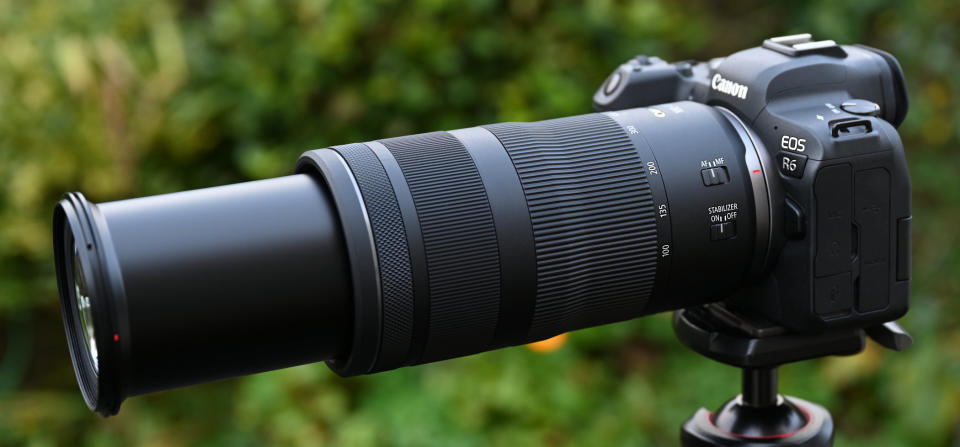
1. Canon RF 100-400mm F5.6-8 IS USM
Mount: Canon RF | Full-frame compatible: Yes | Autofocus type: Nano USM | Stabilizer: 5.5-stop Optical | Minimum focus distance: 0.88m | Filter thread: 67mm | Dimensions (WxL): 79.5 x 164.7mm | Weight: 635g
Fast autofocus and good stabilization
Features a focus-distance scale
Not weather-sealed
Pricier than non-stabilized lenses
The Canon RF 100-400mm f/5.6-8 IS USM is designed for EOS R-series full-frame bodies, on which it’s an excellent fit, making for a slimline and easily manageable overall package.
Autofocus is super-fast, image stabilization is highly effective and image quality is highly impressive in all respects. The aperture rating of f/8 will be limiting if you need a lens to shoot in low light, but that’s the price you pay for the conveniently downsized design – and the actual price is sensible as well.
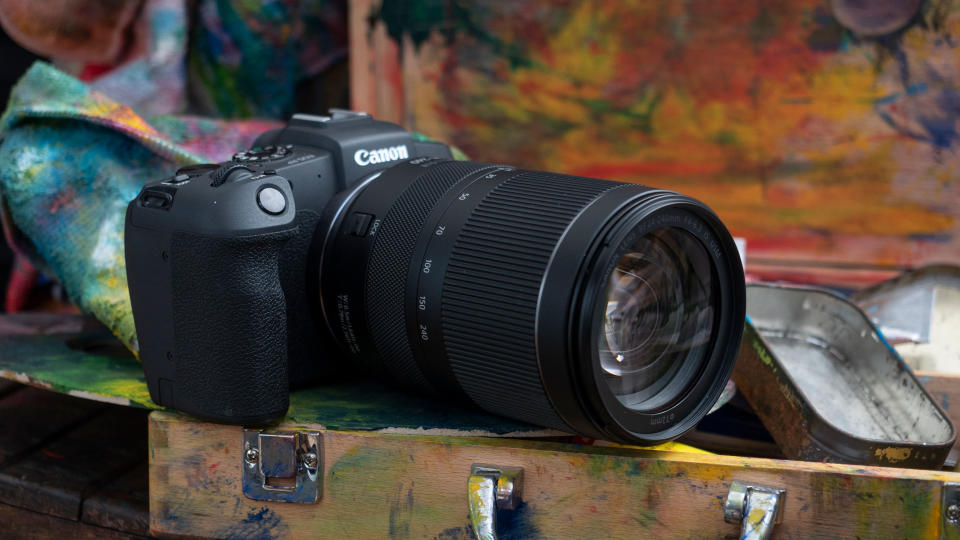
2. Canon RF 24-240mm f/4-6.3 IS USM
The best all-rounder when you just want to carry one lens
Mount: Canon RF | Autofocus: Nano Ultrasonic | Stabilizer: 5-stop | Min focus distance: 0.5m | Max magnification: 0.26x | Filter thread: 72mm | Dimensions (WxL): 80x123mm | Weight: 750g
Monster 10x zoom range
Small and lightweight for a full-frame superzoom
Long-zoom aperture is slow
Slight compromise in image quality
This small and lightweight 'superzoom' is perfect for capturing things right up close or really far away thanks to its massive zoom range. For anyone who likes to shoot with minimal kit, this lens is incredibly versatile and could be used to shoot portraits, landscapes, interiors, architecture, or even wildlife.
It benefits from the same build quality and features as the other RF lenses including fast and accurate autofocus and 4-stops of lens stabilization. Like with all superzoom lenses, there is some compromise on image quality but the 24-240mm still delivers impressive images with little aberrations thanks to in-camera corrections. For anyone who doesn't want the fuss of carrying multiple lenses or changing them frequently, this lens is perfect it weighs just 750g so it won't weigh you down too much.
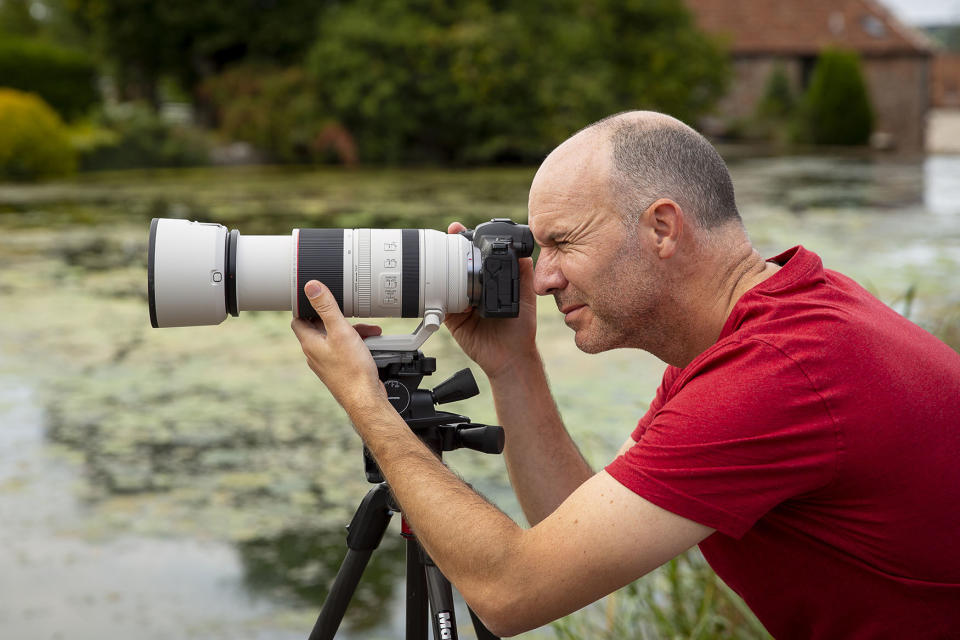
3. Canon RF 100-500mm f/4.5-7.1L IS USM
This native RF mount lens offers even more zoom and amazing image quality
Mount: Canon RF | Full-frame compatible: Yes | Autofocus type: Ultrasonic (ring-type) | Stabilizer: Yes | Minimum focus distance: 0.9-1.2m | Filter thread: 77mm | Dimensions (WxL): 93.8 x 207.6mm | Weight: 1,530g
Great build and image quality
Stellar AF on Canon EOS R5 and R6
Narrow maximum aperture
Disappointing AF on Canon EOS R and RP
The Canon RF 100-500mm is a superb addition to the rapidly expanding range of RF-mount lenses. It combines Canon's legendary L-series build quality with premium optical performance that's up there with the very best Canon zooms we've tested. There is, however, a catch; to really get the most from the AF system – especially for accurate action shots – you’ll need to employ the amazing AF and IBIS on the Canon EOS R5 or Canon EOS R6. Shoot with this lens on the older Canon EOS R or Canon EOS RP and you can expect AF to be noticeably more sluggish, which is somewhat disappointing when you've just dropped big money on a lens like this.
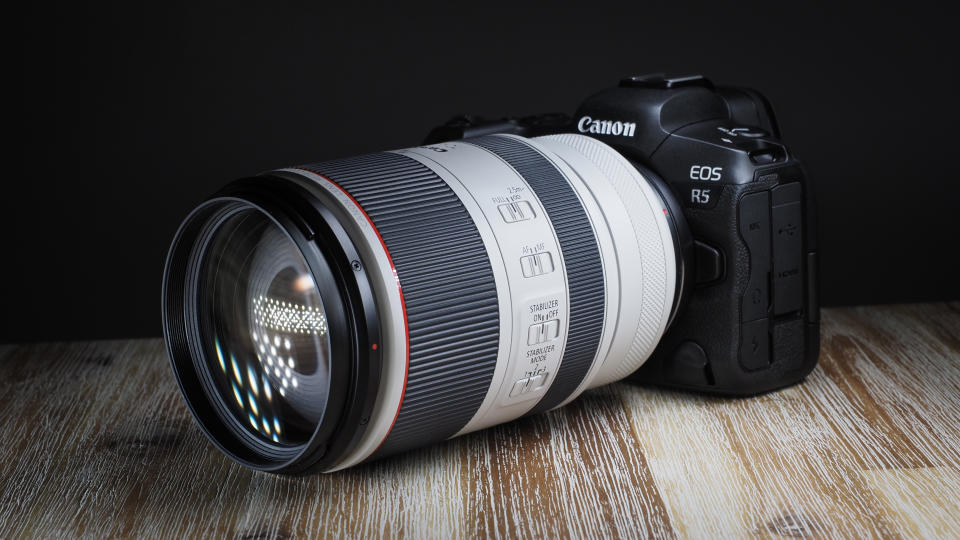
4. Canon RF 70-200mm f/2.8L IS USM
This compact, super-fast telephoto is a great but it's jaw-droppingly expensive
Mount: Canon RF | Full-frame compatible: Yes | Autofocus type: Dual Nano USM | Stabilizer: Yes | Minimum focus distance: 0.7m | Filter thread: 77mm | Dimensions (WxL): 90x146mm | Weight: 1,070g
Super-fast, silent autofocus
5-stop image stabilizer
Barrel extends at full zoom
Very pricey to buy
Unlike most constant-aperture 70-200mm zooms, this Canon lens for EOS R-series cameras has an inner barrel that extends at longer zoom settings. Typical drawbacks are an increased likelihood of dust being sucked into the lens, and the danger of zoom creep. On the plus side, it enables a particularly small stowage size for this class of lens, and it’s relatively lightweight as well, in keeping with EOS mirrorless full-frame cameras. It’s pricey to buy but high-end attractions include super-fast and silent Dual Nano USM autofocus, 5-stop optical image stabilization, a customisable control ring and typically pro-grade L-series build quality. Image quality is superb with fabulous sharpness and minimal aberrations.
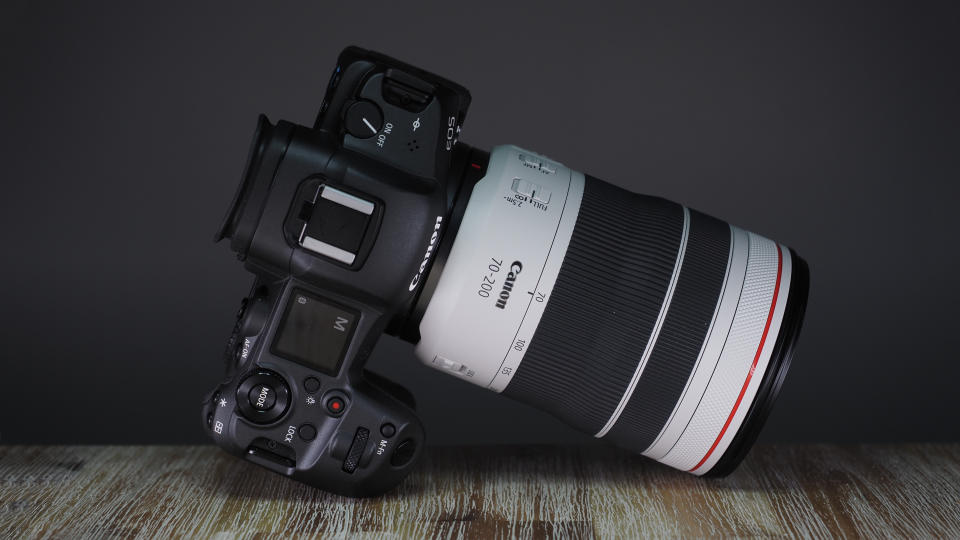
5. Canon RF 70-200mm f/4L IS USM
The smallest full-frame 70-200mm and is incredibly sharp and lightweight
Mount: Canon RF | Full-frame compatible: Yes | Autofocus type: Dual Nano USM | Stabilizer: Yes | Minimum focus distance: 0.6m | Filter thread: 77mm | Dimensions (WxL): 83.5x119mm | Weight: 695g
Shortest (FF) 70-200mm ever
Great center sharpness
Teleconverters not supported
Pricey for an f/4 lens
Canon's RF 70-200mm f/4L IS USM is easily the shortest and lightest 70-200mm f/4 in the world. Side-by-side it's only slightly larger than a soda can when the lens is fully collapsed, while it's shorter and lighter than the f/2.8 variant above. It doesn't compromise on performance though, delivering an impressive 7.5 stops of stabilization (on an EOS R6 or R5 at least), making it incredibly versatile for a range of shooting situations.
Optically and center sharpness is fantastic as well, even at 200mm, though corner sharpness can be a little disappointing. Somewhat frustratingly though the lens is not compatible with teleconverters, while it's very pricey compared to the EF version, which admittedly isn't quite as advanced. Though issues aside, this is a cracking lens for R series shooters.
Best Canon telephoto lenses for EF mount
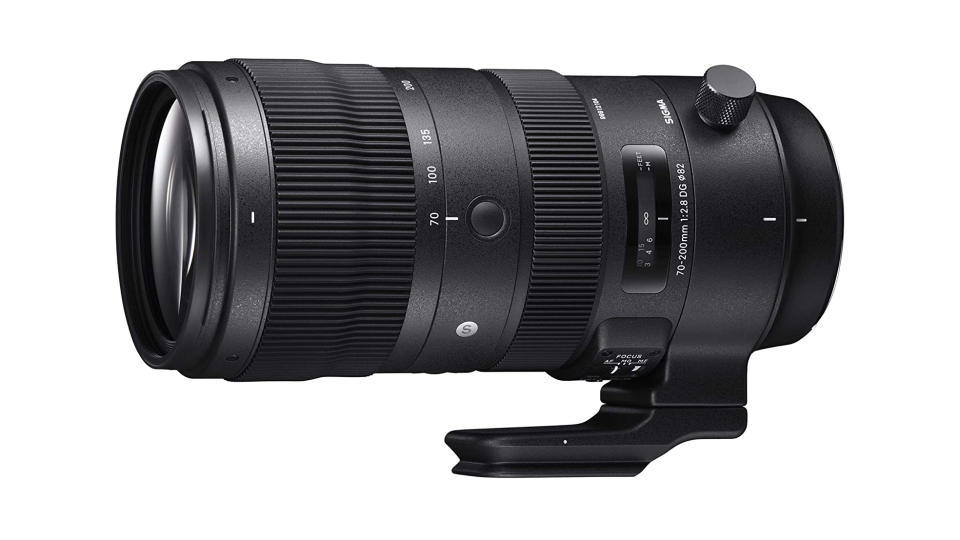
6. Sigma 70-200mm f/2.8 DG OS HSM | S
A top perfoming telephoto zoom ideal for sports and wildlife photography
Mount: Canon EF | Full-frame compatible: Yes | Autofocus type: Ring-type ultrasonic | Stabilizer: Yes | Minimum focus distance: 1.2 | Filter thread: 82mm | Dimensions (WxL): 94x203mm | Weight: 1,805g
Performance and image quality
Customisable controls
Big and heavy for a 70-200mm
Tripod mount isn’t fully removable
Sigma really pushed the boat out when designing this fast, constant-aperture zoom. From the ‘Sports’ line-up of Global Vision lenses, it goes large on speed and performance, as well as physical size. Autofocus is courtesy of a rapid ring-type ultrasonic system, and comes complete with AF on/hold buttons on the barrel, the action of which can be customized in recent mid-range and up-market Canon DSLRs.
The full range of automatic lens aberration corrections is also available, and two switchable dedicated custom modes can be set up with Sigma’s optional USB Dock. The lens is super-sharp even when shooting wide-open, helped in real terms by a highly effective optical stabilizer. The only real downsides are that it’s big and weighty for a 70-200mm zoom, and only the tripod mounting foot is removable (via four Allen screws) rather than the complete mounting ring.

7. Canon EF 70-200mm f/4L IS II USM
The new and improved mark II delivers superior autofocus and stabilization
Mount: Canon EF | Full-frame compatible: Yes | Autofocus type: Ultrasonic (ring-type) | Stabilizer: Yes | Minimum focus distance: 1.0m | Filter thread: 72mm | Dimensions (WxL): 80x176mm | Weight: 780g
Tough yet lightweight build
Superior autofocus and stabilization
Pricier than some 70-200mm f/2.8s
Optional tripod mount expensive
The new and improved 70-200mm Mark II benefits from an upgraded optical design for even better image quality. With more refined lens coatings and new glass elements in a different configuration, ghosting and flare is even less noticeable. Fluorine coatings on the front and rear elements help repel moisture and grease and make the lens easier to clean. It has an optical stabilizer with a 5-stop rating and three switchable operating modes for even sharper images.
Both image quality and handling is excellent and best of all, it weighs about half of what most 70-200mm f/2.8 lenses weigh. The big downside to this lens is it doesn't include a tripod mounting ring which is a pretty essential bit of kit for bird or wildlife photography. You can pick up third-party ones relatively cheap but the Canon official ring is pretty pricey.
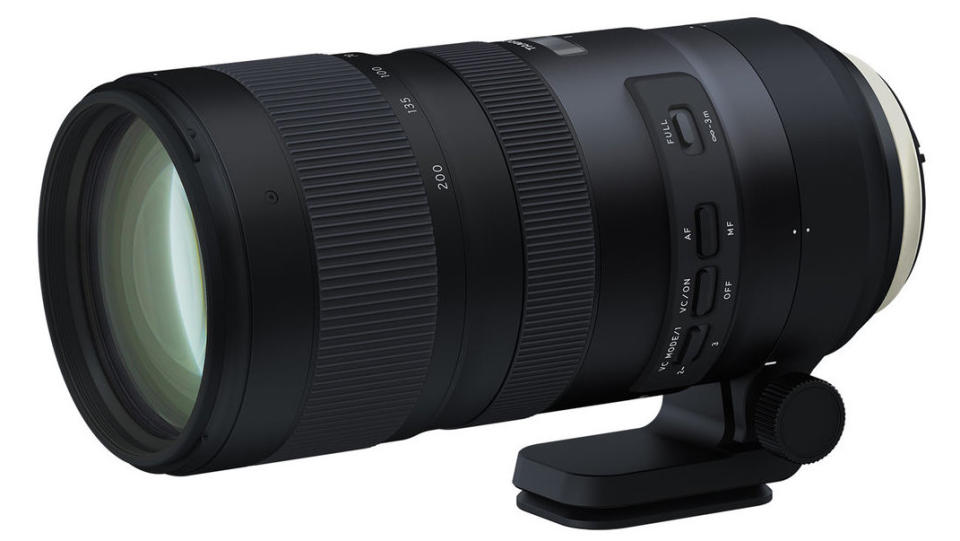
8. Tamron SP 70-200mm f/2.8 Di VC USD G2
Super fast autofocus, pro-grade performance and half the price of the Canon equivalent
Mount: Canon EF | Full-frame compatible: Yes | Autofocus type: Ultrasonic (ring-type) | Stabiliser: Yes | Min focus distance: 0.95m | Filter thread: 77mm | Dimensions (WxL): 88x194mm | Weight: 1,500g
Super-fast autofocus system
Excellent triple-mode stabiliser
Brilliant performance
Switches can be knocked
While the latest edition of Canon’s own 70-200mm f/2.8 stabilized zoom is only a minor refresh of the previous version, (Generation 2) lens benefits from a major revamp.
The new lightning-fast autofocus system is based on dual microprocessors. There’s also a class-leading image stabilizer with 5-stop performance, and it gains two additional operating modes. The three switchable modes are for static and panning shots, plus an option that only applies stabilization during actual exposures, rather than affecting the viewfinder image.
This makes it easier to track erratically moving objects. Unlike the previous edition of the lens, the G2 is also compatible with Tamron’s new tele-converters, which are also extremely good.
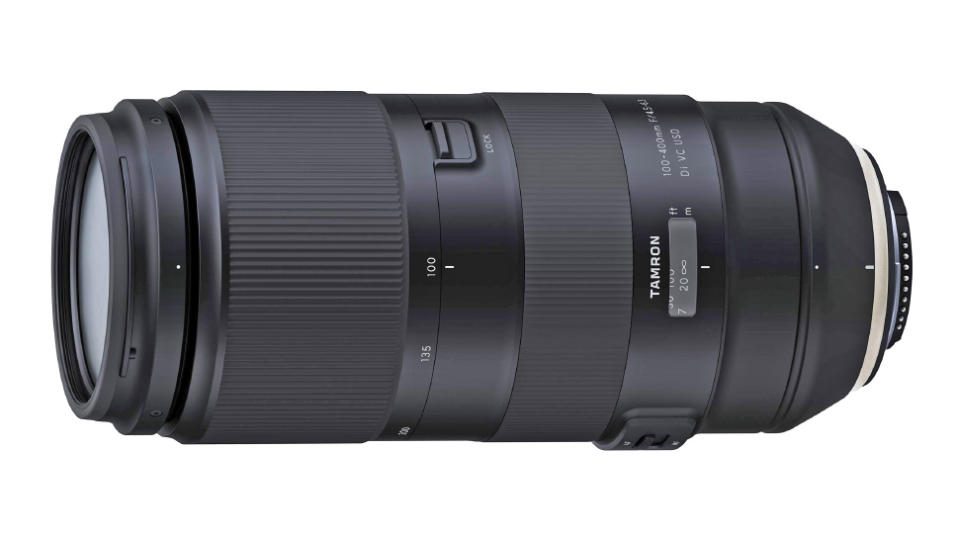
9. Tamron 100-400mm f/4.5-6.3 Di VC USD
Get incredible reach without breaking the bank with this Tamron 100-400mm
Mount: Canon EF | Full-frame compatible: Yes | Autofocus type: Ultrasonic (ring-type) | Stabilizer: Yes | Minimum focus distance: 1.5m | Filter thread: 67mm | Dimensions (WxL): 86x199mm | Weight: 1,135g
Powerful telephoto reach
Reasonably light in build and price
Slow f/6.3 aperture rating at 400mm
Tripod mounting ring sold separately
Weighing in at just over a kilogram, the recently launched only weighs about two-thirds as much as most 70-200mm f/2.8 lenses, but delivers twice the telephoto reach.
It’s a particularly attractive option for photographers who have traded up from an APS-C body to a full-frame camera, and are missing the extra ‘effective’ reach of a 70-300mm lens with a 1.6x crop factor. Well made, the Tamron feels sturdy and incorporates weather-seals.
Handling is refined with super-fast autofocus, a 4-stop dual-mode stabilizer and an autofocus limiter switch that can lock out either the short or long end of the focusing range. Image quality is excellent, on a par with Canon’s much pricier and heavier 100-400mm lens.
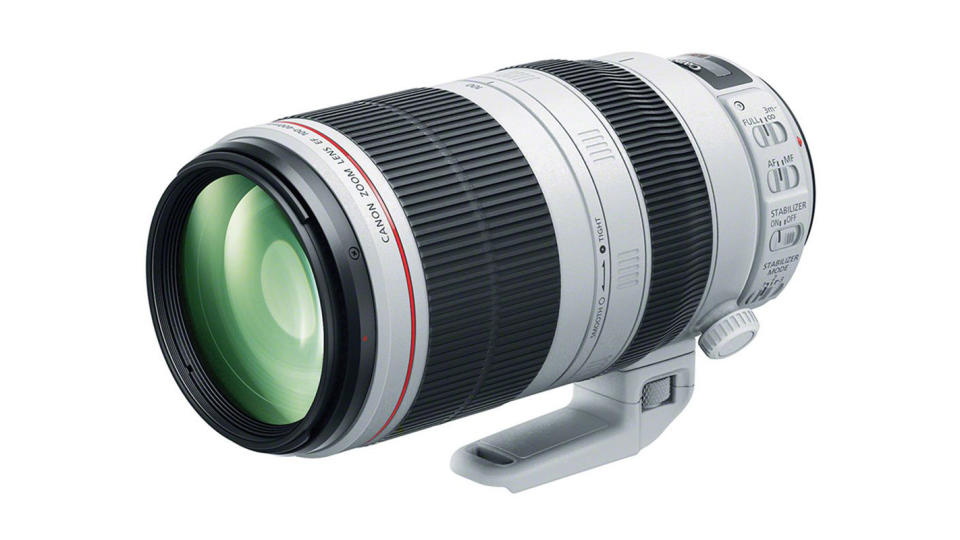
10. Canon EF 100-400mm f/4.5-5.6 L IS II USM
A firm favourite among pros and wildlife photographers
Mount: Canon EF | Full-frame compatible: Yes | Autofocus type: Ultrasonic (ring-type) | Stabilizer: Yes | Minimum focus distance: 0.98m | Filter thread: 77mm | Dimensions (WxL): 94x193mm | Weight: 1,640g
Fully pro-grade build and handling
Very good all-round performance
Big and heavy
Expensive to buy
At around twice the price of the Sigma and Tamron 100-400mm lenses on the market, the Canon EF 100-400mm f/4.5-5.6L IS II USM is a more substantial proposition. It’s about 50 per cent weightier, comes complete with a tripod mounting ring, and has Canon’s typical L-series pro-grade build quality and weather-seals. The Mark II edition of the lens ditches the trombone style push-pull zoom mechanism and adopts a more conventional twist ring.
However, it still incorporates the adjustable friction damper for the zoom mechanism, as featured on the original lens, which helps to avoid zoom creep. Top-class glass includes fluorite and Super UD (Ultra-low Dispersion) elements, along with ASC (Air Sphere Coating) to minimize ghosting and flare, and fluorine coatings on the front and rear elements. There’s a 4-stop triple-mode image stabilizer and very fast autofocus. All in all, it’s a better lens than the original edition in every respect.
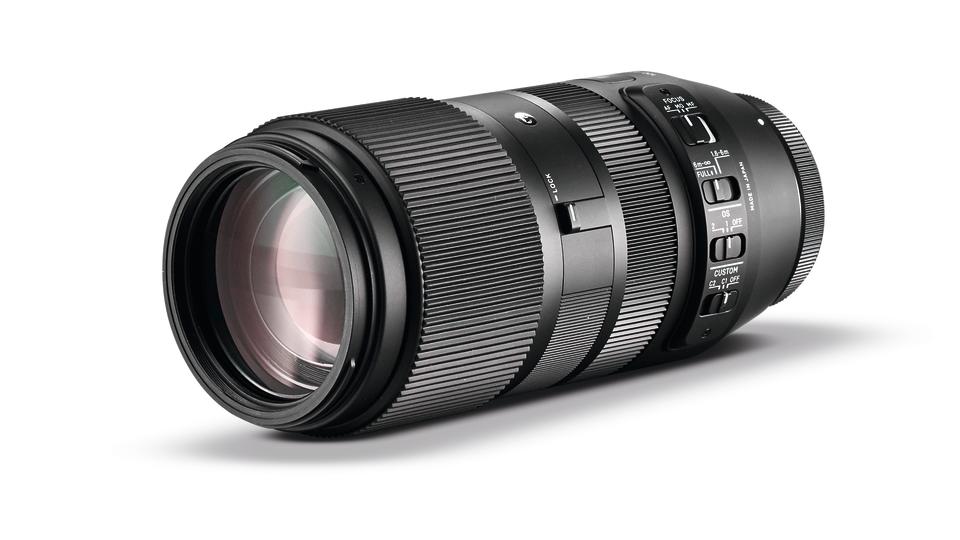
11. Sigma 100-400mm f/5-6.3 DG OS HSM | C
A great value, compact lens that still delivers sharp, high-quality images
Mount: Canon EF | Full-frame compatible: Yes | Autofocus type: Ultrasonic (ring-type) | Stabilizer: Yes | Minimum focus distance: 1.6m | Filter thread: 67mm | Dimensions (WxL): 86x182mm | Weight: 1,160g
Small and light for a 100-400mm lens
Great handling and performance
No optional tripod mounting ring
Lacks a full set of weather seals
Slightly smaller and more lightweight than the competing Tamron lens, and much more compact than the Canon, Sigma’s ‘Contemporary’ class 100-400mm zoom nevertheless feels very well built. The zoom and focus rings work with a smooth, fluid feel and you can also operate the zoom mechanism with push-pull action. Indeed, the supplied lens hood is specially shaped for this purpose.
High-quality optics incorporate four SLD (Special Low Dispersion) elements, while up-market features include extremely quick ring-type ultrasonic autofocus with three switchable focus modes. As such, you can give priority to either automatic or manual override in dual-mode AF, as well as selecting a purely MF setting. You can also apply custom settings to the new-generation image stabilizer and autofocus system, via Sigma’s optional USB Dock.
In our tests, the Sigma proved marginally less sharp than the competing Tamron 100-400mm but there’s very little in it, and the level of customization is superior. One disappointment, however, is that no optional tripod mounting ring is available for Sigma.
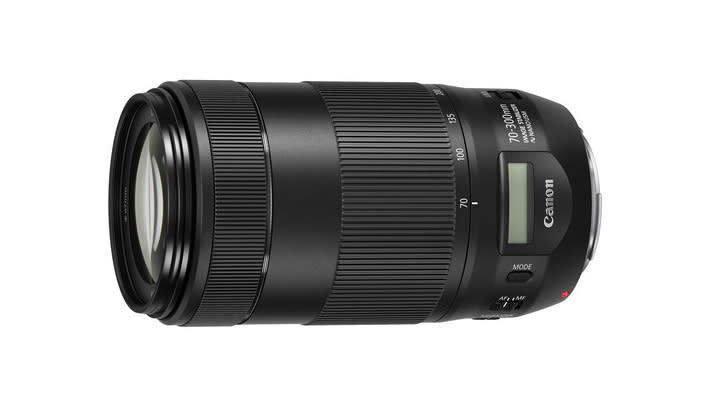
12. Canon EF 70-300mm f/4-5.6 IS II USM
The best buy 70-300mm for Canon DSLRs
Mount: Canon EF | Full-frame compatible: Yes | Autofocus type: Nano USM | Stabilizer: Yes | Minimum focus distance: 1.2m | Filter thread: 67mm | Dimensions (WxL): 80x146mm | Weight: 710g
Impressive AF and stabilization
Smart LCD info display
Hood costs extra
Lacks weather seals
A massive improvement over the original Canon 70-300mm IS USM, this Canon EF 70-300mm f/4-5.6 IS II USM has a much faster Nano USM autofocus system that’s virtually silent, yet gives smooth transitions for video capture.
It’s like the best of ultrasonic and stepping motor systems rolled into one and, unlike in the previous lens, the focus ring no longer rotates during autofocus. The image stabilizer is also much improved, with a 4-stop rating, and image quality is much sharper with better contrast.
Another nice touch is that there’s an LCD screen on the barrel with a pushbutton for cycling through display modes. These include focus distance and depth of field, effective focal length on an APS-C format camera, and the current level of vibration.
Shockingly the lens hood for this lens is sold separately - but save yourself money by buying a third-party version, which is much better value than the Canon ET-74B original.
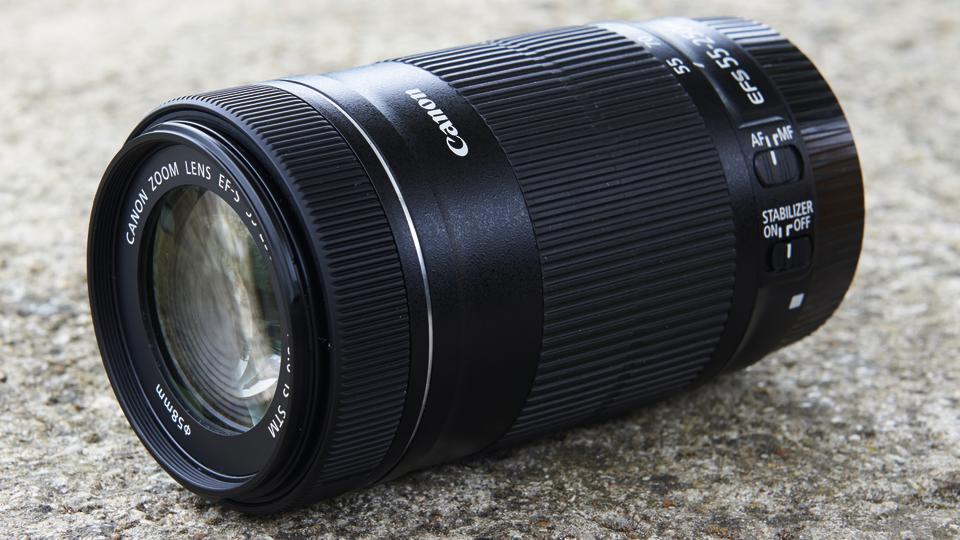
13. Canon EF-S 55-250mm f/4-5.6 IS STM
The best APS-C format EF-S lens for Canon
Mount: Canon EF-S | Full-frame compatible: No | Autofocus type: Stepping Motor | Stabilizer: Yes | Minimum focus distance: 0.85m | Filter thread: 58mm | Dimensions (WxL): 70x111mm | Weight: 375g
Very compact and lightweight
Virtually silent autofocus system
Plastic mounting plate
Lens hood costs extra
The Canon EF-S 55-250mm f/4-5.6 IS STM is one of the most lightweight telephoto lenses available at just 375g! This is partly due to the fact it has plastic rather than metal plating but it's also pretty compact and specifically designed for APS-C Canon cameras.
Unfortunately, that does mean it isn't compatible with full-frame sensors as it has a small image circle which would cause vignetting on larger sensors. It's more sophisticated than the IS II model that it's replaced and the virtually silent STM (stepping motor) autofocus system is faster and gives even smoother autofocus transition when using it to shoot videos.
Its low price is another selling point of this lens but be warned, like all non-Canon L series lenses, the hood will need to be bought separately and they're not as cheap as you might think.
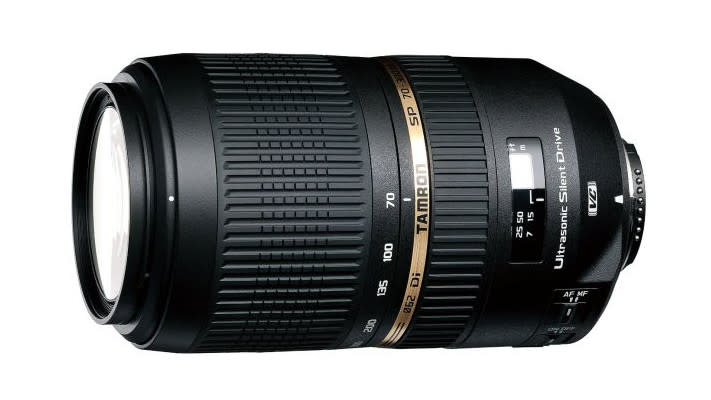
14. Tamron SP 70-300mm f/4-5.6 Di VC USD
It's not the cheapest but it does have image stabilization for better handling
Mount: Canon EF | Full-frame compatible: Yes | Autofocus type: Ultrasonic (ring-type) | Stabilizer: Yes | Minimum focus distance: 1.5m | Filter thread: 62mm | Dimensions (WxL): 82x143mm | Weight: 765g
Fast autofocus and good stabilization
Features a focus-distance scale
Not weather-sealed
Pricier than non-stabilized lenses
This isn’t the cheapest 70-300mm lens on the market, as both Sigma and Tamron make cheaper non-stabilized options. However, it adds fast and highly effective ring-type ultrasonic autofocus, which improves performance and handling, and includes the bonus of optical image stabilization. Both of these features tend to be lacking in cheaper 70-300mm lenses.
Given that Canon DSLRs don’t feature sensor-shift stabilization for shooting stills, stabilization is practically a ‘must-have’ feature for handheld telephoto shooting. Although it’s not weather-sealed, the Tamron is very well built for such an inexpensive lens. It also delivers very good image quality with impressive sharpness and contrast. Unlike Canon’s similarly priced lenses, the Tamron comes complete with a hood.
Best Canon telephoto lenses for EF-M mount
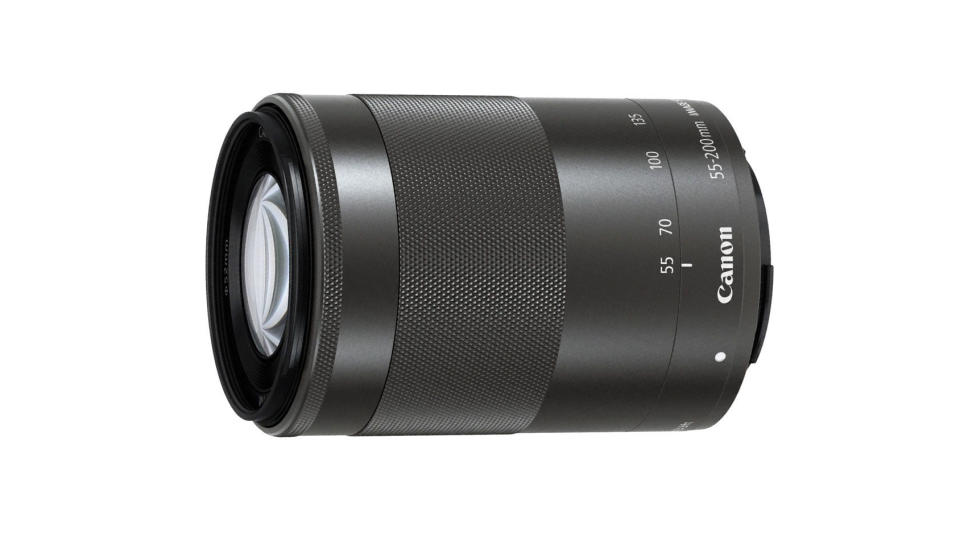
15. Canon EF-M 55-200mm f/4.5-6.3 IS STM
The best telephoto zoom for EOS M system cameras
Mount: Canon EF-M | Full-frame: No | Autofocus: Yes | Stabilization: Yes | Lens construction: 17 elements in 11 groups | Angle of view: 27.8-7.8 degrees | Minimum focusing distance: 1.0m | Maximum magnification ratio: 0.21x | Filter size: 52mm | Dimensions: 61x87mm | Weight: 260g
Fast stepping motor autofocus
3.5-stop image stabilization
Super-lightweight for a tele zoom
No easy-access mode switches
Lacks weather-seals
Hood sold separately
There’s little point investing in one of Canon’s dinky little EOS M cameras if you need to hang a big hefty lens off the front. Thankfully this one is amazingly compact and lightweight, yet delivers an impressive 88-320mm ‘effective’ zoom range in full-frame terms. It’s simple to use and boasts speedy stepping motor autofocus plus image stabilization, although downsizing comes at the cost of a modest aperture rating and sharpness could be better.
How we test lenses
We test lenses using both real-world sample images and lab tests. Our lab tests are carried out scientifically in controlled conditions using the Imatest testing suite, which consists of custom charts and analysis software that measures resolution in line widths/picture height, a measurement widely used in lens and camera testing. We find the combination of lab and real-world testing works best, as each reveals different qualities and characteristics. More on how we test and review here.

